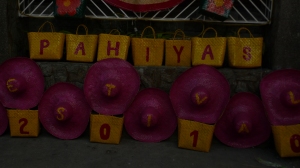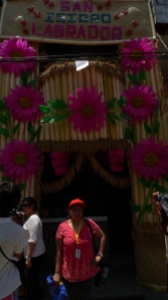by Prime Sarmiento
Thank goddess for entrepreneurs!
In fact had not been for this photo booth that was set up by a group of twenty-something entrepreneurs, I won't have any souvenir photo of me enjoying this year's Pahiyas festival in Lucban,Quezon. 
I forgot to recharge both my digicam and video cam the night before and so by 3 p.m., I was practically just lugging my stuff around as batteries went kaput
Which is just too bad as I only managed to participate in this year's Pahiyas by signing up with a travel agency's Photoholic Pahiyas tour – a package tour organized specifically for photo buffs.
And while I managed to take some pics and even had some video shots of the parade of carabaos (water buffaloes), I really wished I could have taken more. A dozen more. Which is why I envy the thousands of tourists who trooped here in Lucban, last May 15, with their cameras (and fully recharged batteries, I bet), snapping up photos of all those decorated houses that can only be found during the Pahiyas. 
Pahiyas is perhaps one of the most colorful fiestas in this Southeast Asian country known for its numerous festivities.
Pahiyas is celebrated every May 15 in Lucban – one of the towns comprising the province of Quezon. Like most fiestas in the Philippines, Pahiyas is celebrated in honor of a Catholic saint – in this case, San Isidro Labrador (Saint Isidore), the patron saint of farmers. Agriculture, after all, is a major industry in Lucban and the month of May is harvest season in Quezon (and in most of the farming areas around the Philippines).
The word "Pahiyas" is derived from the local vernacular "payas" meaning "decoration or to decorate". One of the highlights of the festival are the facade of the houses decorated with crops. Lucbaenos do not only do this just to offer their thanksgiving to San Isidro but also to ask for blessing that the next cropping season will be abundant. 
Every household has its own decorative motif. Some decorate their homes with the fresh produce- red, plump tomatoes, winter melon, rice stalks, corn, bananas. In some houses where they raise pigs, families fashion out pigs out of coconut coir. Or some put up an "anok" – a scarecrow-like human replica made of rice straw, coco coir and saw-dust. Others decorate their houses with hats, mats and bags made of buntal fiber (obtained from leaves of a local palm variety) used in making hats — making and selling of these fashion accessories is a cottage industry in Lucban.
Perhaps, the most famous house decor in the Pahiyas is the "kiping" -brightly colored leaf shaped wafers made of rice, salt and food color. The kiping will then be arranged to create any design – such as a giant flower or a chandelier.
 Those house decors also serve a practical purpose. Every year, the local government launches a contest where the best house decor wins a prize including cash, live carabao, sacks of rice and household appliances. This encourages Lucbaenos to be more creative with designs and also lures more tourists, not to mention corporate sponsors for the concert and parade.
Those house decors also serve a practical purpose. Every year, the local government launches a contest where the best house decor wins a prize including cash, live carabao, sacks of rice and household appliances. This encourages Lucbaenos to be more creative with designs and also lures more tourists, not to mention corporate sponsors for the concert and parade.
And where there are tourists, there's definitely an area for souvenir shopping. And I'm not just talking about the huge bazaar situated behind the church, but most of the stores and stalls at the city center, selling all sorts of things – from the usual souvenir items like t-shirts and key chains to fashion accessories like buntal hats dyed in brilliant colors including pink and violet. (I;m just glad that none of these stores accept credit cards because I would have ended up buying another hat or bag which I'll probably just use once)
But the bestseller is longganisang Lucban – garlicky pork sausage which goes well with steamed rice, tomatoes and coconut vinegar with spices. Although I'm no pork eater, I had to get several packs for my parents who requested for them.
I had to go to several shops before I managed to buy four packs, as most of the stores have ruin out of longganisa supply, as hordes of tourists were buying loads of longganisa. I also bought some espasol – cylinder-shaped rice cakes made of rice flour, coconut milk and sweetened coconut strips which I ate in the van on my way back to Manila.
***
Travel tips
What to bring: Pahiyas is celebrated every 15th of May, and since the weather is quite warm, it's best that you bring sunblock lotion, towel, bottled water and a hat (although you can just buy a buntal hat there). Wear comfy clothes – t-shirt, shorts and slippers (bring extra t-shirt too as you might perspire a lot because of the crowds and the heat). If you're a shopaholic, bring cash (lots of them), as no store accepts credit cards. And if you're a photoholic, don't forget to recharge your batteries.
How to go there: Lucban is about 150 km south of Manila- the Philippine capital and it will take you 3 to 4 hours to travel there by land. You can take the bus going either to Sta Cruz in Laguna or Lucena City, the capital of Quezon, bus fare is 200 to 300 pesos (or about 8 U.S. dollars) one way. From there, you can take the jeepney going to Lucban.
The following bus companies ply through the Manila-Laguna-Quezon route:
1. BLTB
Location: Edsa, Pasay City
Telephone Numbers: + 63 2 833 5508, + 63 2 833 5501, + 63 2 913 1525
2. Inland Trailways Incorporated
Location: Edsa, Pasay City.
Telephone Numbers: +63 2 833 6280.
3. JAM Transit
Location: Taft Avenue, Pasay City; New York Street, Cubao, Quezon City.
Telephone Numbers: +63 2 541 4409, +63 2 924 7712, +63 2 831 4390.
Travel Agency: There are several agencies in Manila that offer day tours to Lucban during the Pahiyas. I advise that you join one of these tours as it;'s really a hassle to go there alone as you might end up stranded in Lucban because you can't get a seat in a jam-packed bus. Don't even think of staying in a hotel here for the night as they're booked and you need to reserve a room at least two years before the next Pahiyas.
I personally recommend Travel Factor (www.travelfactor.org), as it's affordable (a tour package costs 1,600 pesos (about 40 U.S. dollars) per person, incl of transportation, food and insurance) and will give you a chance to meet other travelers.